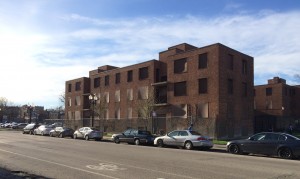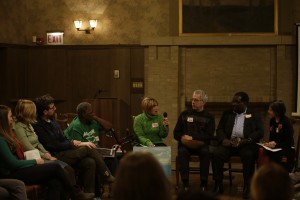Interpreting the past, wrestling with the present
24 July 2015 – Richard Anderson

Chicago’s Jane Addams Homes opened in 1938 during the first wave of public housing construction by the federal government. Jane Addams, whose Hull House Settlement stood less than one mile away, encouraged New Deal officials to choose a site in her Near West Side neighborhood. The last remaining building from the complex, pictured above, has been slated to host the National Public Housing Museum. Photo credit: National Public Housing Museum
Last year, I served as research resident at the National Public Housing Museum (NPHM), which focuses on the history of public housing across the country but especially in its home city of Chicago. The NPHM will one day occupy the last remaining building from the New Deal-era Jane Addams Homes in the Little Italy neighborhood. One weekend, as I volunteered at the museum’s information booth during Little Italy’s annual street festival, a passerby asked incredulously, “This is going to be a museum?” nodding to the NPHM’s future home. “But weren’t these projects?” Residents like this man had wondered for years what would happen to the boarded-up building and surrounding empty lots. Sensing an interpretive opportunity, I engaged him in a long conversation about the history of public housing and the museum’s goal of illuminating the racial and class assumptions that marked “The Projects.” I don’t think he walked away as a champion of the NPHM, but the museum exists in large part to stimulate just such conversations.
The interpretive program of the NPHM will recover the history of families and communities deliberately isolated and stigmatized by a range of private- and public-sector housing policies. Using a model similar to the Lower East Side Tenement Museum, the museum’s central exhibit will recreate the apartments of specific families from different periods in the history of the Jane Addams Homes. By challenging narratives about public housing residents in the past, the museum will also stress that social and racial equality remains closely tied to housing issues in the present.
But the politics of housing in the present is where things get tricky. Although the Chicago Housing Authority (CHA) agreed to donate the property to the NPHM, the process is tied up with a larger public-private redevelopment of the old public housing land. In the early 2000s, the CHA began demolishing the Jane Addams Homes as part of its Plan for Transformation, a frequently delayed, much-criticized $1.5 billion effort to replace or refurbish 25,000 public housing units with mixed-income, racially integrated residential communities.[1] The plan promised displaced CHA residents a “right to return” to the new developments, but many are still waiting.
The city rebranded the site surrounding the Jane Addams Homes as “Roosevelt Square,” and construction of new market-rate housing and commercial space began in the mid-2000s. A modest number of subsidized units have gone up, but the land where the Jane Addams Homes stood remains vacant. Last year, the city decided to update the master plan for Roosevelt Square. The museum build-out can only begin when city officials, developers, and community groups agree on a revised plan. The completed Roosevelt Square will certainly contain subsidized units, yet it would be a shame if the museum opens in a neighborhood that marginalizes public housing residents. After all, they–as the NPHM will document–have been an integral part of the neighborhood since the Great Depression.
Throughout my time at the NPHM, I wondered how the institution would navigate the treacherous terrain where race, public policy, real estate development, and history meet. This spring, I had a series of conversations with Todd Palmer, NPHM associate director and curator, about the museum’s relationship to broader changes afoot in Roosevelt Square. On the question of whether the NPHM will facilitate gentrification, Palmer observed that the situation is distinct from the case study ethnographer Cathy Stanton presented in The Lowell Experiment. Here, the museum is a product, not a cause, of gentrification. The physical transformation of the neighborhood will occur with or without the museum. Furthermore, the impetus for the museum came from residents of the Jane Addams Homes.
In negotiations between the CHA and the residents when the Plan for Transformation started, the residents insisted on a museum for the new development. CHA residents will help determine the NPHM’s future and shape its narrative. They currently work with the museum as board members, interns, and volunteers. For the last four years, a Youth Advisory Council consisting of current CHA residents, has conducted oral histories and other outreach programs. In the future, the youth and other CHA residents will help develop exhibit content through a community-curation model.
The most cynical take on the museum would be that it provides a socially-conscious cover for a land grab. I disagree. The contradictions of present-day housing policies, the struggles over the CHA’s overhaul, and the often-unrealized promise of mixed-income development will receive significant attention in the museum’s programming and interpretive plan. Palmer said that the permanent exhibits would discuss the origins of the museum and its relationship to the Plan for Transformation. Furthermore, he sees the museum as one response to the limitations of the mixed-income panacea. Palmer noted that even when such developments get built, “co-location,” rather than social integration, usually results. For example, an NPHM intern who is African American and lives in a subsidized apartment in a new South Side development speaks of the palpable fear she senses from her neighbors in market-rate homes. Since mixed-income development does not by itself generate meaningful exchanges across class and race, institutions like the NPHM must “catalyze” them, Palmer argued.

Last December the NPHM hosted “Telling Belongings,” an evening of storytelling around the theme of objects related to home. Maria Sopeña (center, with microphone), a current public housing resident and community advocate, shared her family’s story of immigrating to Chicago from Cuba. Photo credit: National Public Housing Museum
I witnessed one such exchange in December when the NPHM brought together a cross-section of Chicagoans for an evening of storytelling around the theme of objects related to home and family. Some of us resided in public housing and some did not. Yet we laughed and cried together as we shared memories of religious traditions, childhood games, and lost loved ones.
The NPHM cannot by itself fix the flaws in the Plan for Transformation, I am confident, however, that it will provide a literal and figurative space for Chicagoans in Roosevelt Square and across the city to wrestle with the contemporary legacy of poisonous public housing policies and possibly chart a more equitable future.
[1] For a brief but helpful discussion of the Plan for Transformation, see NPHM board member D. Bradford Hunt’s Blueprint for Disaster: The Unraveling of Chicago Public Housing (Chicago: University of Chicago Press, 2009), 278-84. Hunt’s history of the Chicago Housing Authority is indispensable for understanding the racial geography of the city in the twentieth- and early twenty-first-centuries.
~ Richard Anderson is a doctoral candidate in twentieth-century American history at Princeton University. He received an MA in public history from the University of Massachusetts Amherst.




This sounds like a fantastic new public history site. Your story reminds me of the NPR piece I heard about the new play, “The Projects.” http://www.npr.org/2015/06/17/415274516/the-projects-explores-the-evolution-of-chicagos-public-housing-system
Have you had an opportunity to see it? There are probably a good number of cross-disciplinary arts opportunities here.
Thanks for your comment, Adina. “The Projects” is fantastic. It captures all the aspects of the public housing story–social life, racial dynamics, public policy challenges–that the NPHM will wrestle with in its programming and interpretive work. The theater company held a benefit performance for the NPHM in May. And museum board member Brad Hunt, whose scholarship I mentioned in this post, is one of the people portrayed in the play.